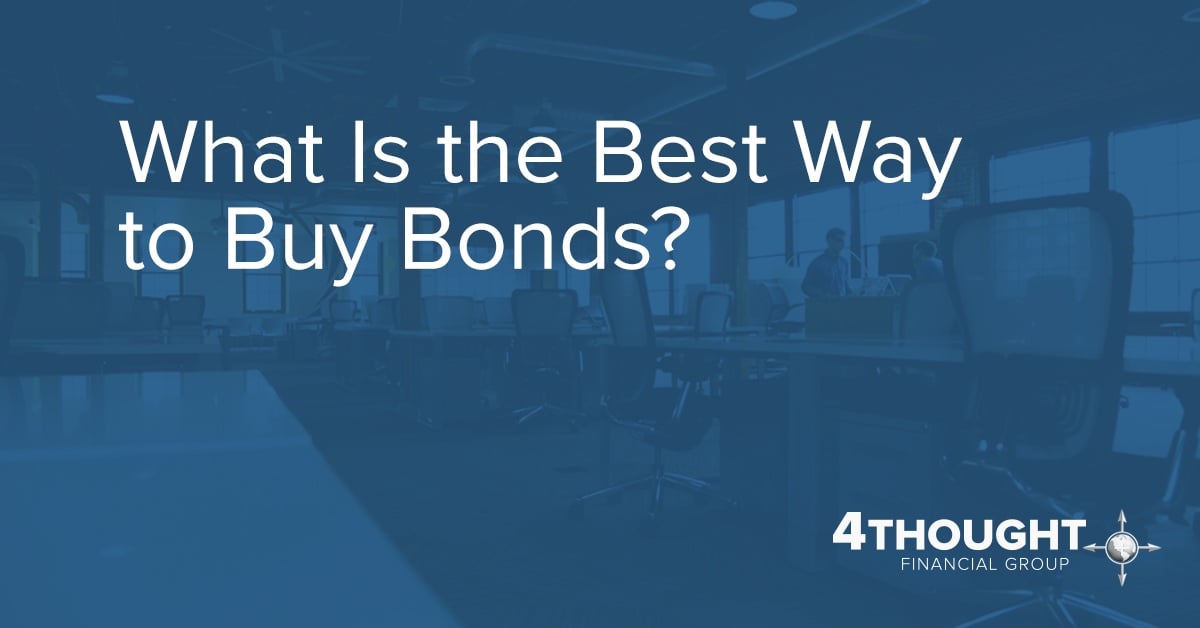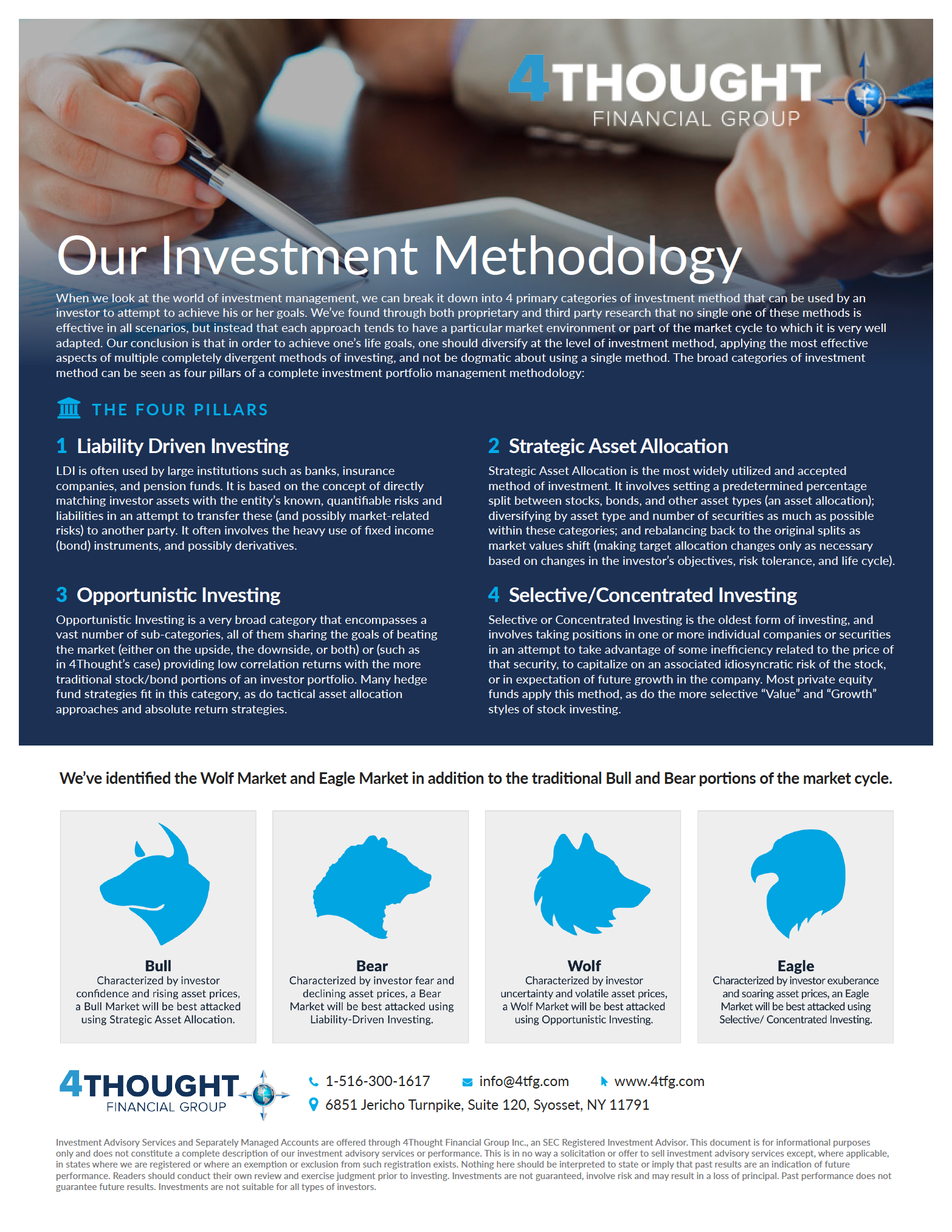

4Thought Financial Group's Unique Investment Methodology
"In order to achieve life goals, one should diversify at the level of investment method, applying the most effective aspects of multiple, completely divergent methods of investing, and not be dogmatic about using a single method"
Learn more about the 4Thought Financial Group Investment Methodology
An appropriate answer to this question may depend on several factors, including the specific objectives of the investor, the amount of investable assets, the expected direction of interest rate changes, and many others. But in the absence of such specifics, there are traits of different available bond investment vehicles with which all bond investors should be familiar, regardless of what market environment may be forthcoming.
While this list is not exhaustive, the following three potential investment vehicles may be used as the basic building blocks of the bond portfolio:
Individual Bonds
Purchasing individual bond contracts issued by a corporation or government on the secondary over-the-counter market is the traditional way to build a bond portfolio. When you buy a bond, you are essentially making a loan to a company or government entity, and they are agreeing to pay you interest on the loan during its lifetime, with the principal of the loan (in the form of the par value of the bond) due back to you on the maturity date.
Directly purchasing the actual bond contracts of an issuing entity (instead of through a pooled vehicle) confers the major advantage of providing the option to hold until the maturity date. This is important, because although the market value of the bond will fluctuate during the holding period, it essentially means that if you buy a bond and hold it to maturity, you are likely to get back everything you invested, plus interest—even if interest rates rise significantly and hurt your bond’s market value during the interim period. Granted, this leaves aside any considerations related to call provisions, convertibility, or other complicating factors. But the chief advantage of the individual bond purchase is the relative certainty of the investment, in which your rate of return can conceptually be locked-in and calculated in the form of the yield-to-maturity. However, if the investor sells the bond prior to the maturity date, any certainty goes right out the window, as the investor will receive only whatever the market value happens to be on that date (at the price the specific investor is able to get at sale on the over-the-counter market).
Also importantly, the major drawback to building a portfolio of individual bonds is default risk. Just like making a loan to your friend down the street, when you buy a bond and make a loan to a corporation or government, the entity could potentially default on the loan, and either fail to make specific interest payments, or fail to pay back the par value at maturity (either in whole or in part). So the relative certainty in the yield-to-maturity of the investment must be tempered by the understanding that the entirety of the investment could be lost in the event of a default.
To counteract this major risk, it is most often recommended that if an investor wishes to use individual bonds to build their portfolio, he or she should diversify and purchase a large number of them from a variety of companies, industries, geographies, credit risks, etc., in order to minimize the potentially catastrophic effects of a default on a large position. The problem with this is that for many individual investors this level diversification is out of reach—as individual bonds are usually bought and sold in increments of $10,000 to $15,000 or more per bond trade (depending on the market), which means one may need a portfolio of $500,000 to $1,000,000 or more to build a reasonably diverse portfolio.
In summary, the upside of individual bonds is the ability hold to maturity, while the downside is default risk.
Bond Mutual Funds and Bond Exchange Traded Funds
The conventional alternative to buying individual bonds for the retail investor is to purchase shares of open-end bond mutual funds. When you purchase bond mutual funds, you are not actually purchasing the bonds themselves, but are instead purchasing shares of an investment company that holds and manages an underlying portfolio of bonds.
The downside of open-end mutual funds is that they do not have a maturity date like individual bonds, and thus there is no option to hold to maturity (if interest rates rise) to get back what you put in, plus interest. In this sense, investing in bond mutual funds is more like an equity investment as opposed to “true fixed income,” because the portfolio returns are entirely variable, with no predictable endpoint, although the fluctuations in portfolio value are likely to be less than those of stocks because of the lower-volatility nature of bond prices in general (historically, all things being equal). All of this is also true of most bond exchange traded funds (ETFs), which have become an increasingly common and lower-cost alternative to open-end mutual funds over the last 20 years or so.
So why would anyone buy bond mutual funds or ETFs? The answer is diversification.
Each fund may hold an underlying portfolio of many individual bonds (often 50 to 100, or more), and if you hold several bond funds of different types, you can potentially achieve great portfolio diversity with only a small amount of money (many mutual funds can be purchased with only a $1,000 or even lower initial investment). This diversity can drastically diminish the risk of bond issuer default that would otherwise be associated with investing in individual bonds. This is a major benefit, and as a result, this type of investment has historically been the vehicle of choice for most retail bond investors.
In summary, the upside of bond mutual funds and ETFs is diversity (and the corresponding reduced default risk), while the downside is the lack of ability to hold to maturity (because there is no end date).
Target Date Bond Exchange Traded Funds
A newer bond investment vehicle that has only been around since about 2010 is the target date (or target maturity) bond exchange traded fund. This a subcategory of the ETF world that seeks a happy medium between the individual bond portfolio and the open-end bond mutual fund. Technically this is indeed a fund (like other ETFs or mutual funds), but it behaves a bit more like an individual bond, because it actually has a future maturity date on which it will convert to cash.
The target date bond ETF is essentially a wrapper that holds a large number of individual bond issues within it, and the investor owns shares of the fund (an investment company), just like with any other mutual fund or ETF. This confers it the same diversity advantage that all bond funds have, drastically reducing default risk relative to the alternative of buying a handful of individual bonds oneself. But the difference between target date bond ETFs and other bond ETFs is that all of the underlying holdings inside the target date ETF wrapper mature at or about the same time (typically within about a three-month period prior to the ETF maturity date). Once all the bonds inside the target date bond ETF have matured and converted to cash, the ETF itself converts to cash, leaving a lump sum in the investor’s brokerage account.
As a result, the target date bond ETF has a market value that acts very similarly to an individual bond. If you sell it prior to maturity, you’ll get whatever the market value is at the time, but if you hold it to maturity, you should expect to get back whatever you put into the investment, plus interest—reduced by the internal fees/expenses of the ETF and any defaults in the underlying portfolio. The target date bond ETF attempts to provide a little of the best of both worlds when it comes to individual bonds and mutual funds—the ability to hold to maturity of a bond, and the reduced default risk of a fund.
The primary disadvantage of this arrangement relative to buying individual bonds is cost. The ETF will have an expense ratio that detracts from the underlying portfolio’s return and reduces the fund’s dividend yield relative to the exact same set of holdings if held outside the ETF wrapper (but most retail investors would not be able to replicate such portfolios anyway—so for most people, this fee is probably worth paying). When you consider that you can use a whole portfolio of such vehicles to build a bond ladder or bulleted bond portfolio with varying maturities just as you can with individual bonds, and that this ETF portfolio can be adjusted and sold in very small increments at market prices if needed (as opposed to potentially having to sell the entire position at an inopportune time as may be the case in some situations with individual bonds), then these vehicles become even more attractive for the retail investor.
"While the answer will inevitably depend on the particular situation... most retail investors would be well-served by the use of the target date bond ETF as a basic building block of the portfolio."
So what is the best way to buy bonds?
While the answer will inevitably depend on the particular situation of the investor, and on the cost minimization that he/she is able to achieve by selecting the right combination of brokerage, custodian, and Registered Investment Adviser, most retail investors would be well-served by the use of the target date bond ETF as a basic building block of the portfolio.
This is due mainly to its reduced default risk relative to individual bonds (through underlying issuer diversity), and the more predictable returns pattern available relative to open-end mutual funds and non-target-date ETFs (given the option to hold to maturity if interest rates rise and market values decline).
Regardless of which vehicle is chosen as the basic portfolio building block, it is important that the overall portfolio is managed on an ongoing basis and properly coordinated with the other portfolio assets (like stocks, real estate, etc.)—which for most retail investors involves enlisting the aid of a professional advisor and/or portfolio manager.
4Thought Financial Group
Do rising interest rates have you questioning your bond portfolio? 4Thought Financial Group uses target date bond exchange traded funds and other diversifying fixed income assets to manage portfolios for clients, reducing default risk relative to individual bonds, and reducing interest rate risk relative to bond mutual funds. Contact 4Thought today to find out more, or open an account today with a minimum investment of only $500.00 for taxable accounts ($10,000.00 for IRAs).







Leave a Comment